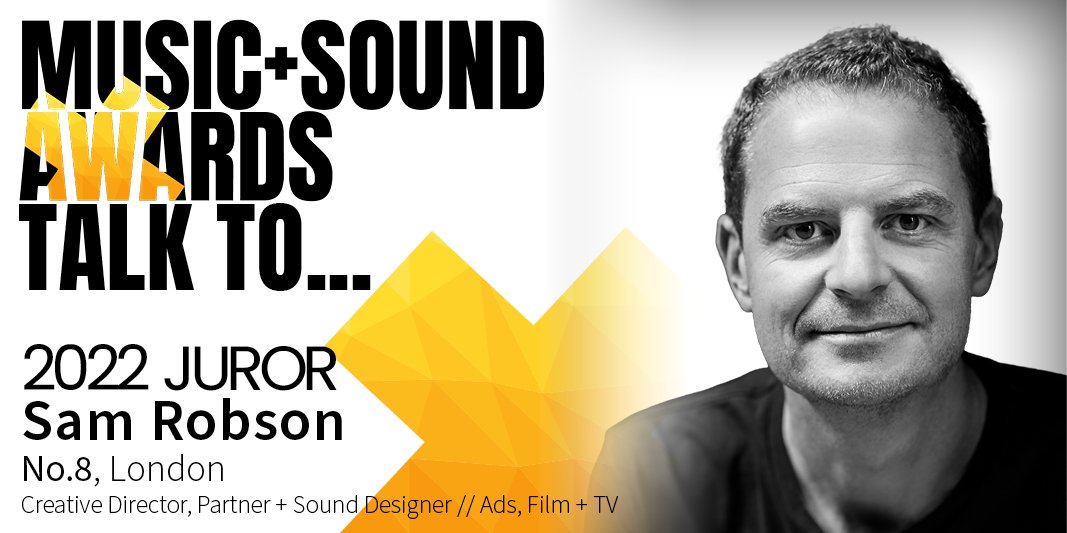March 2022
Sam Robson is Creative Director of Audio and a Partner at No.8, one of our official sponsors this year.
With over 20 years of industry experience, Sam has been involved in some of the most iconic advertising campaigns in recent memory, with a skill set encompassing TV, cinema, online and radio.
His work has featured heavily in industry award shows - with notable personal sound design achievements including a Music+Sound Award, a D&AD Yellow Pencil, BTA Craft Arrows Gold and Cannes Lion. Sam is also a regular on a number of global award panels for sound and advertising craft.
Recent standout creative work includes campaigns for Womens Aid, FIFA and Audible as well as Greenpeace, Great Western Railway and Lynx.
Here we have a chat and find out more…
MASA: Can you tell us a little about your career path to date and how you initially got a foot in the doorway of the industry?
SAM: Like most sound designers, it all starts with making countless cups of tea and taking the most of any opportunities that come your way. My Dad worked in radio sales and sponsorship and had a good relationship with a studio manager in Soho, so when I was given the chance to learn on the job over going to university, I took it.
MASA: In 2020 you joined No.8 as Creative Director of Audio and partner of the business. How are you settling in?
SAM: Really well thanks. We’ve moved on hugely in the last twelve months in terms of company growth. Our services are spread over audio, VFX and colour and so we’ve found ourselves having to expand into another building to accommodate for that growth. The new space is great, with new colour suites, production floor and a lovely bar area for clients to hang out in.
MASA: You’ve worked on some huge ads during your career. Do any stand out as favourites? And have there been any particularly challenging one?
SAM: I think the mantra of ‘putting the same amount of passion and enthusiasm into every job you work on’ still holds firm, and that we as sound designers have a big say in bringing an idea to life. I’m extremely proud to have my work recognised in awards shows and like to think work such as ‘Women’s Aid’ and ‘Greenpeace’ are impactful on a much wider scale too.
Our company-wide collaboration on ‘Fifa’ was particularly challenging and enjoyable because there were so many moving parts. A lot of the soundscapes were built from the ground up which, over the course of so many shifting scenes, made this a real challenge in complimenting what was developing visually.
MASA: What’s your studio space like? What’s your favourite piece of gear?
SAM: Funnily enough we’re just in the process of refurbishing all three audio suites which is very satisfying to see! All the rooms at No.8 have a very homely and relaxed feel to them. For a start there’s no real barrier between client and engineer which makes for a much more collaborative environment.
In terms of kit, the audio team have been putting our heads together with George Castle, who’s recently joined us from GCRS, to share each other’s knowledge on plug-ins and workflows, which has been very useful. We’ve invested in creative tools like Cargo Cult Envy which nails what used to be a tricky sound brief really well.
MASA: On an average project how much do you rely on libraries as opposed to recorded or synthesized sounds?
SAM: I tend to use libraries as a starting point for ease of speed and have a few go-to favourites. For Foley and very specific sounds I’ll either record these in the studio or at home internally / externally depending on the environment I’m trying to capture. Having a portable mic which you can plug straight into your phone is always very handy if you’re out and about and hear something you think could be useful in the future!
MASA: Sound can be one of the hardest things to communicate to a non-sound person! How do you overcome this with directors at the planning stage? And do you find that most directors are happy for you to take the lead with ideas?
SAM: If someone has an idea in their head, it’s usually conveyed by some sort of reference they’ve seen and enjoyed. It’s then our job to get as close to that sound as possible, whilst also putting our own spin on it to make it feel unique. A lot of what we do for TV obviously has to relate to what you’re seeing on the screen; but it makes the project more enjoyable if you have the trust of everyone, including the director, to push the boundaries and experiment a little.
MASA: How do you think a competition like The Music+Sound Awards impacts the industry?
SAM: Ever since it started, MASA has always been a unique show, as all the work is judged and recognised by your peers rather than a jury consisting of multi-disciplines. It’s also very much a huge contributor in allowing the industry to recognise and appreciate how much sound and music contribute to a piece of work.
MASA: And lastly, what will you be looking for when judging? What makes a piece of work worthy of a Music+Sound Award?
SAM: Whenever I’m fortunate enough to judge an awards show, I always look for work which makes me really question how the sound was executed. If you’re sat watching film after film, there needs to be a uniqueness to the overall craft of the sound to make it standout.
MASA: Thank you so much, Sam. It’s great to learn more about No.8 and so good to have you on the jury this year, especially since you’re a previous Music+Sound Awards’ winner yourself!
Find out more about No.8 HERE
And enter The No.8 Award for Best Sound Design in Broadcast Advertising HERE



